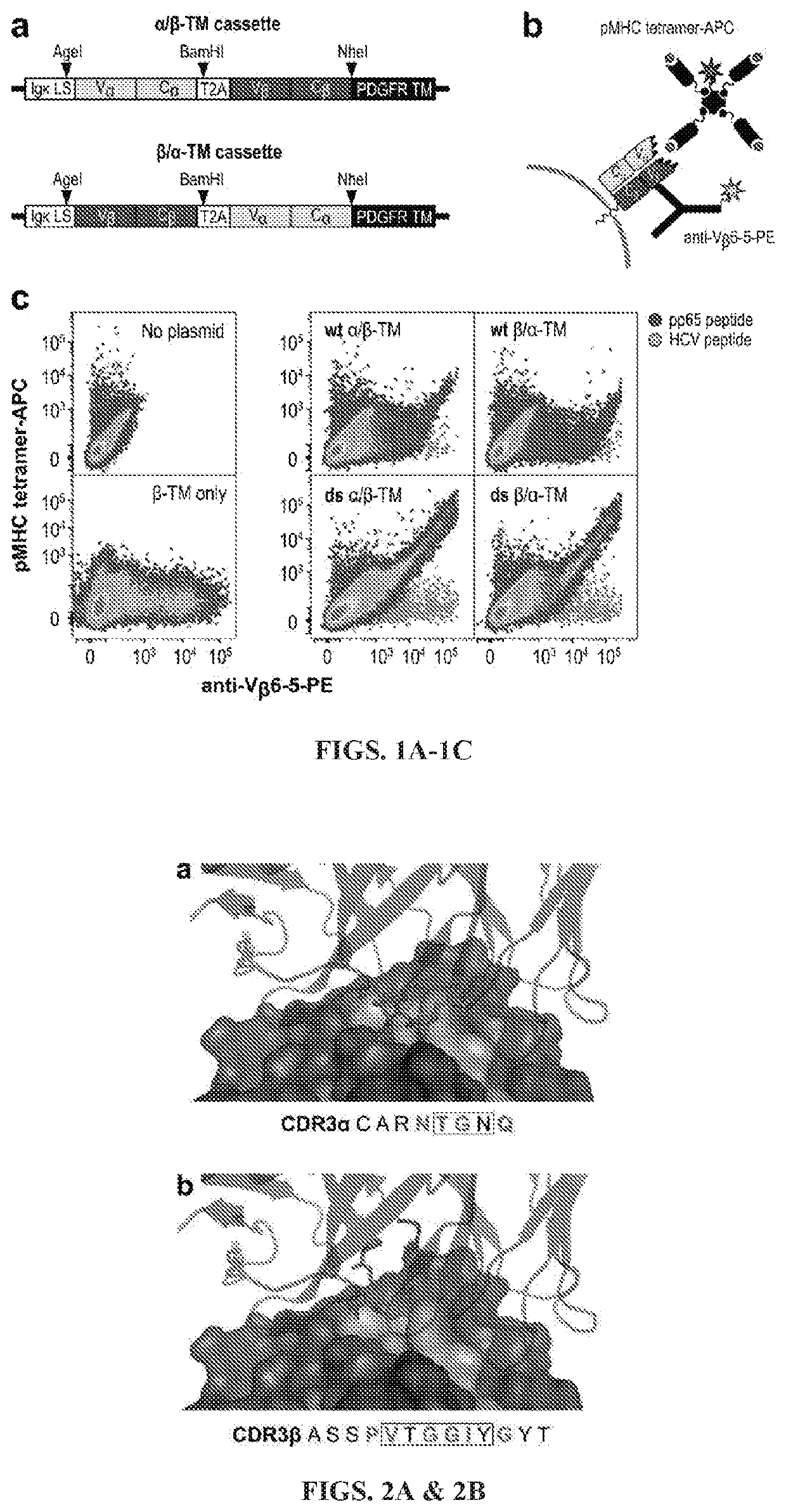High affinity engineered t-cell receptors targeting cmv infected cells
- Summary
- Abstract
- Description
- Claims
- Application Information
AI Technical Summary
Benefits of technology
Problems solved by technology
Method used
Image
Examples
example 1
f Pp65 NLV-Specific TCR RA14 on the CHO Cell Surface
[0191]To first determine the level of recombinant TCR displayed on the CHO cell surface, the truncated extracellular alpha and beta chains of the human RA14 TCR were cloned into a pcDNA3-based plasmid with a CMV promoter, human IgH leader sequence, one TCR chain, and T2A peptide sequence followed by the second TCR chain fused in-frame to a platelet-derived growth factor receptor (PDGFR)-derived transmembrane region (FIG. 1A). As only the second chain is fused to the transmembrane region and chain order can impact yields (Maynard et al., 2005), the chains were cloned in both the α / β-TM and β / α-TM orientations. Similarly, since moving the terminal inter-chain di-sulfide bond to the Cα:T84C and Cβ:S79C position (IMGT numbering used throughout) and removing the free cysteine at position Cβ85.1 has been reported to improve expression of soluble and phage / yeast displayed TCRs (Boulter et al., 2003; Ho et al., 1998), these modifications w...
example 2
CDR3α and CDR3β Libraries
[0194]Analysis of the RA14-NLV / A2 crystal structure revealed that RA14 engages nearly all solvent-exposed peptide residues and forms hot spots with peptide residues P4:Pro, P5:Met and P8:Thr (Gras et al., 2009). In the alpha chain, CDR3α:N114 forms a key hydrogen bond with P5:Met which is also present in structure of the related TCR C7 with NLV / A2 (Yang et al., 2015), which has a nearly identical CDR3α. In the beta chain, CDR3β:T110 forms multiple hydrogen bonds with P8:Pro. To identify high affinity RA14 variants, separate CDR3α and CDR3β libraries were designed, which allowed a larger sequence space for each CDR to be probed. Three anchor residues (Vα:N114, Vβ:T110 and Vβ:Y114) were retained while four or six residues flanking these contacts were randomized to optimize the TCR-pMHC interface (FIG. 2).
[0195]To create each library, primers incorporating degenerate codons were designed to maximize amino acid diversity while keeping the theoretical library siz...
example 3
of RA14 Variants with Improved Tetramer Binding
[0196]Pooled library plasmids were diluted with a 1:4 molar ratio of carrier DNA, to ensure each cell will acquire at most one library clone, and transfected into CHO-T cells (Nguyen et al., 2018). After two weeks of growth under antibiotic selection to eliminate cells lacking the pPy plasmid, cells were stained with AlexaFluor-647 (AF647)-labelled NLV / A2-tetramers to detect ligand binding and anti-Vβ6-5-PE to detect surface TCR display. Each library was sorted by FACS to collect the 1-2% of cells with the highest ratio of tetramer binding to TCR display. After sorting, each library was allowed one week of recovery before being sorted again, for a total of three rounds. Comparison of the libraries at each step demonstrated enrichment of clones with high levels of tetramer binding (FIGS. 3A-B). The CDR3α and CDR3β libraries each showed a 5-10-fold increase in the number of cells falling within the gated area per round.
[0197]TCR sequences...
PUM
| Property | Measurement | Unit |
|---|---|---|
| Fraction | aaaaa | aaaaa |
| Fraction | aaaaa | aaaaa |
| Fraction | aaaaa | aaaaa |
Abstract
Description
Claims
Application Information
 Login to View More
Login to View More - R&D Engineer
- R&D Manager
- IP Professional
- Industry Leading Data Capabilities
- Powerful AI technology
- Patent DNA Extraction
Browse by: Latest US Patents, China's latest patents, Technical Efficacy Thesaurus, Application Domain, Technology Topic, Popular Technical Reports.
© 2024 PatSnap. All rights reserved.Legal|Privacy policy|Modern Slavery Act Transparency Statement|Sitemap|About US| Contact US: help@patsnap.com










